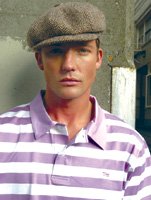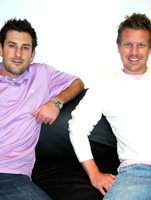Green Party: Golf Gets Fashionable
Johan Lindeberg is a revolutionary, but his grass-roots campaign is more about verdant fairways than underground hideouts.
“I decided to change the world by changing golf,” said the Swedish designer. “Because so many decision makers play golf, if I can get these guys to discover a more modern look, they will probably start to think more modern.”
Lindeberg embodies a peculiar combination of reverence for golf’s traditions and the rebelliousness of a mischievous schoolboy. In 1997, his radical revision of golf apparel landed like a meteor on the putting green of complacency when he dressed the iconoclastic Jesper Parnevik in pink pants for the Byron Nelson Classic. Though the look received scorn and derision from the golf establishment, Parnevik won the tournament—and Lindeberg won the first round in his battle to reform the sport he loves.
In August, the 47-year-old former chief executive officer of Diesel USA will open a J.Lindeberg boutique in the Beverly Center in Los Angeles, his second U.S. retail location. With headquarters in Stockholm and design studios in London, the rapidly growing fashion house is projecting $25 million in gross sales this year, up 35 percent from last year. The line offers both menswear and womenswear, from suits to dresses, but it is with the one-third devoted to slim, sleek golfwear that Lindeberg has made a name for himself.
Lindeberg launched his label with over-exaggerated slim cuts for maximum shock value. Citing heroes Arnold Palmer (whom he calls the Marlon Brando of golf) and Mick Jagger, Lindeberg has restrained himself as his line has grown. But he still dresses PGA poster boys Fredrik Jacobson and Aaron Baddeley in body-sculpting silhouettes that are now and wow without jettisoning athletic function. The designer calls his signature white belt, ultramodern in its sportiness and simplicity, “the hottest accessory in golf right now.”
“We’re starting to be seriously respected,” said the designer on a recent trip to Los Angeles. “It’s really turning around.”
Even Donald Trump, hardly known for a fashionable image, called the New York J.Lindeberg store requesting a custom shirt.
Like a royal family indifferent to the outside world, the golf establishment was ripe for being overthrown. One of the few professional sports played in everyday clothing rather than a special uniform, the sport has seen its apparel evolve from the plus fours, argyle sweaters and tweed caps of a Scottish gentleman to the loud plaid and clashing colors of the 1970s. Then sometime in the ’80s, the sport adopted the equivalent of a fast-food uniform, with legs swallowed up in swathes of pleated khaki and torsos evaporated inside pup tents of double-mercerized cotton. Tack on that most pernicious of straight-guy vices, the baseball cap, and the look is as dull as can be, making it an amusing irony that most golf courses maintain strict dress codes.
The devolution of golf attire coincides with the rise of corporate sponsors needing a blank canvas on which to attach their logos. The democratizing spirit brought by players such as Tiger Woods seems to have resulted in everyone dressing down. And as a final factor, golfers have not exactly been known for having the kind of lean physiques that look good in Prada.
Europeans, on the other hand, are much more style-conscious on the links, said Lindeberg, who nevertheless intended the United States as his primary market when he started his line. Golf must strive for a balance between country-club exclusivity and a “public and sloppy” devolution in dress as the sport becomes less elitist, he said.
West Coast style
The United States has 36.7 million “golf participants,” defined as anyone over the age of 5 who has visited a golf facility in the past 12 months, according to the National Golf Foundation. Forty-five percent of participants are between the ages of 18 and 39. Altogether, golfers spend nearly $1 billion per year on apparel.
European design houses Hugo Boss, Giorgio Armani and Burberry have all sought a piece of the action to varying degrees of success. So has Chris Rosaasen, who saw a hole in the market while working at a pro shop during college and started his golf apparel label, Rosasen, as a senior project. Today the 5-year-old company grosses $5 million in sales and expects to double that figure in the next few seasons.
Rosaasen saw a burgeoning demographic of younger golfers eager to think outside the boxy shirt. “We would never have been crazy enough to start a men’s fashion brand,” he said, but golf apparel had plenty of upside.
For his first collection, Rosaasen and partner Dave Kasischke hired designer Dorene Williams, who was on leave from Adidas. Rosaasen said the line is priced better than Lindeberg’s and is “more all-American,” with looser-fitting cuts that are still slim by golf standards. Wholesale prices are $35 to $65 for shirts and top out at $200 for cashmere sweaters.
About 40 percent of the brand’s sales come from resorts and pro shops. Rosasen is also sold at Fred Segal Santa Monica and American Rag and will hit Bloomingdale’s for Fall 2004. For Spring 2005, the company will launch a women’s line, created by lead designer Jillian Houser. It will hit showrooms in July for a January 2005 delivery. The line will consist of the same well-received men’s styles but in women’s cuts. Look for plenty of plaids and argyles in a “preppy boy style,” Rosaasen said.
The company recently signed a deal with a Canadian licensee and is scouting retail sites in Las Vegas. Rosaasen opened a retail store in November 2003 at 415 N. Robertson Blvd. in West Hollywood, Calif.
San Diego–based Planet Golf is another fashion-forward golf brand that has been revitalized by new investors and innovative designs. Founded in 1992 by Lon Davis and J.C. Wynkoop, two Venice Beach surfer/golfers, the label quickly earned a cult following for its youthful designs before a falling out in 2000 put the brand on hiatus. Planet Golf was bought in January 2003 by private investor John Hardisty and is run by President Ned McMahon, former director of marketing for surf brand Town & Country. The brand continues to hold licenses in Canada and Japan and will sign a deal with a South African licensee in the next month.
“There’s so much good publicity the guys before have done that it’s carrying over,” McMahon said. “It’s not like starting from scratch.”
Buyers have unanimously deemed Planet Golf’s look fresh, McMahon said, for its fashion-forward color combinations, such as chocolate brown and baby blue, and its five different neck treatments. Its most innovative item is the “Freedom Shirt,” which uses only one piece of fabric for the entire top of the shirt, offering both style and freedom of movement. The brand has also bucked the establishment by offering 48 T-shirt designs (most golf courses require shirts with a collar). The line wholesales from $9 to $45 and is designed by Julie Hunt and McMahon’s brother Mark, who has worked stints at Polo Ralph Lauren and Giorgio Armani.
In January, Planet Golf showed women’s samples on the LPGA tour, which McMahon said were well received. A women’s line will be unveiled after the men’s line is more firmly established. Planet Golf is presently finalizing deals with Nordstrom Inc. and The May Department Stores Co.
























